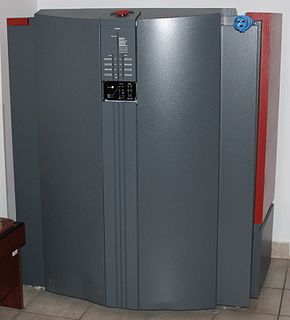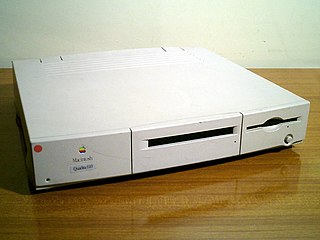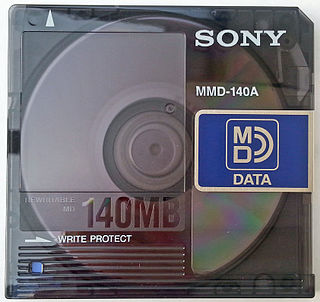 W
WAdobe Acrobat is a family of application software and Web services developed by Adobe Inc. to view, create, manipulate, print and manage files in Portable Document Format (PDF).
 W
WAOL Mail is a free web-based email service provided by AOL, a division of Verizon Communications.
 W
WThe Apple Adjustable Keyboard is an ergonomic keyboard introduced by Apple Computer, Inc. in 1993 for the Macintosh family of personal computers. The keyboard attaches to the computer via the Apple Desktop Bus port. The last Apple computer released compatible with this keyboard without using a USB to ADB adapter was the Power Macintosh G3, as it was the last one with the Apple Desktop Bus.
 W
WThe Newton is a series of personal digital assistants (PDAs) developed and marketed by Apple Computer, Inc. An early device in the PDA category, it was the first to feature handwriting recognition. Apple started developing the platform in 1987 and shipped the first devices in 1993. Production officially ended on February 27, 1998. Newton devices ran on a proprietary operating system, Newton OS; examples include Apple's MessagePad series and the eMate 300, and other companies also released devices running on Newton OS. Most Newton devices were based on the ARM 610 RISC processor and all featured handwriting-based input.
 W
W.bm is the Internet country code top-level domain (ccTLD) for Bermuda. It was originally delegated in March 1993 to Bermuda College and was redelegated to the Registrar General of Bermuda, the de facto manager of the .BM domain, in 2007.
 W
WThe Cray EL90 series was an air-cooled vector processor supercomputer first sold by Cray Research in 1993. The EL90 series evolved from the Cray Y-MP EL minisupercomputer, and is compatible with Y-MP software, running the same UNICOS operating system. The range comprised three models:EL92, with up to two processors and 64 megawords of DRAM in a deskside chassis: dimensions 42×23.5×26 inches or 1050×600×670 mm and 380 lb/172 kg in weight. EL94, with up to four processors and 64 megawords of DRAM, in the same cabinet as the EL92. EL98, a revised Y-MP EL with up to eight processors and 256 megawords of DRAM in a Y-MP EL-style cabinet.
 W
W.cz is the country code top-level domain (ccTLD) for the Czech Republic. It is administered by CZ.NIC. Registrations must be ordered via accredited domain name registrars.
 W
WOptiPlex is a line of business-oriented desktop computers from Dell Technologies aimed at corporate enterprises, healthcare, government, and education markets. The systems typically contain Intel CPUs, beginning with Celeron and Pentium and currently with the Core microarchitecture. Business-oriented components, such as Gigabit Ethernet, DisplayPort, Tool-less Chassis and software such as data protection utilities, along with management features such as Intel vPro often come standard with OptiPlex systems. OptiPlex configurations can be completed by the purchaser for components such as CPU, GPU, RAM, Storage and Wireless options, as well as Dell Pro support. A professional edition of Microsoft Windows comes preinstalled and Linux Dell n Series options are also available.
 W
WThe EO is an early commercial tablet computer that was created by Eo, Inc., and released in April 1993. Eo was the hardware spin-out of GO. Officially named the AT&T EO Personal Communicator, it was similar to a large personal digital assistant with wireless communications, and competed against the Apple Newton. The unit was produced in conjunction with David Kelley Design, frog design, and the Matsushita, Olivetti and Marubeni corporations.
 W
W.hn is the Internet country code top-level domain (ccTLD) for Honduras.
 W
WThe HP 200LX Palmtop PC, also known as project Felix, is a personal digital assistant introduced by Hewlett-Packard in August 1994. It was often called a Palmtop PC, and it was notable that it was, with some minor exceptions, a MS-DOS-compatible computer in a palmtop format, complete with a monochrome graphic display, QWERTY keyboard, serial port, and PCMCIA expansion slot.
 W
WThe HP 200LX Palmtop PC, also known as project Felix, is a personal digital assistant introduced by Hewlett-Packard in August 1994. It was often called a Palmtop PC, and it was notable that it was, with some minor exceptions, a MS-DOS-compatible computer in a palmtop format, complete with a monochrome graphic display, QWERTY keyboard, serial port, and PCMCIA expansion slot.
 W
W.hr is the Internet country code top-level domain (ccTLD) for Croatia.
 W
W.lv is the Internet country code top-level domain (ccTLD) for Latvia.
 W
WThe Macintosh Color Classic is a personal computer designed, manufactured and sold by Apple Computer, Inc. from February 1993 to May 1995. It has a "all-in-one PC" design, with a small, integrated 10″ Sony Trinitron display at 512 × 384 pixel resolution.
 W
WThe Macintosh LC III is a personal computer designed, manufactured, and sold by Apple Computer, Inc. from February 1993 to February 1994. It replaced the commercially successful Macintosh LC II in Apple's lineup of mid-range computers, and was significantly faster, with MacWorld Magazine benchmarks showing 2x performance in all major categories - CPU, disk, video and maths. It was also significantly less expensive; the LC III with an 80 MB hard disk was priced at US$1,349 at introduction, $700 less than the LC II. The LC III was sold primarily to educational institutions, and a corresponding Performa variant called the Performa 450 was sold to the consumer market.
 W
WThe Macintosh Quadra 605 is a personal computer designed, manufactured, and sold by Apple Computer, Inc. from October 1993 to July 1996. The model names reflect a decision made at Apple in 1993 to follow an emerging industry trend of naming product families for their target customers – Quadra for business, LC for education, and Performa for home. Accordingly, the Performa 475 and 476 was sold in department stores and electronics stores such as Circuit City, whereas the Quadra was purchased through an authorized Apple reseller.
 W
WThe Macintosh Quadra 610, originally called the Macintosh Centris 610, is a personal computer designed, manufactured and sold by Apple Computer from February 1993 to July 1994. The Centris 610 was introduced alongside the larger Centris 650 as the replacement for the Macintosh IIsi, and it was intended as the start of the new midrange Centris line of computers. Later in 1993, Apple decided to follow an emerging industry trend of naming product families for their target customers – Quadra for business, LC for education, and Performa for home – and folded the Centris 610 into the Quadra family.
 W
WThe Macintosh Quadra 650, originally called the Macintosh Centris 650, is a personal computer designed, manufactured and sold by Apple Computer from February 1993 to September 1994. The Centris 650 was introduced alongside the smaller Centris 610 as the replacement for the Macintosh IIci, IIvi and Quadra 700, and it was intended as the start of the new midrange Centris line of computers. Later in 1993, Apple decided to follow an emerging industry trend of naming product families for their target customers – Quadra for business, LC for education, and Performa for home – and folded the Centris 650 into the Quadra family.
 W
WThe Macintosh Quadra 660AV is a personal computer designed, manufactured and sold by Apple Computer Inc. from July 1993 to September 1994. It was introduced alongside the Quadra 840AV; the "AV" after both model numbers signifies video input and output capabilities and enhanced audio.
 W
WThe Macintosh Quadra 800 is a personal computer that is a part of Apple Computer's Quadra series of Macintosh computers.
 W
WThe Macintosh Quadra 840AV is a personal computer designed, manufactured and sold by Apple Computer, Inc. from July 1993 to July 1994. It was introduced alongside the Centris 660AV, the "AV" after both model numbers signifying video input and output capabilities, as well as enhanced audio. The 840AV has the same mini tower form factor as the Quadra 800, with a faster Motorola 68040 processor.
 W
WThe Macintosh TV is a personal computer with integrated television capabilities released by Apple Computer in 1993. It was Apple's first attempt at computer-television integration. It shares the external appearance of the Macintosh LC 500 series, but in black. The Macintosh TV is essentially a Performa 520 that can switch its built-in 14" Sony Trinitron CRT from being a computer display to a cable-ready television. It is incapable of showing television in a desktop window, although it can capture still frames to PICT files.
 W
WMD Data is a magneto-optical medium for storing computer data. Sony wanted MD Data to replace floppy disks, but the Zip drive from Iomega ended up filling that market need and, later on, the advent of affordable CD writers and very cheap blank CD media, coupled with the availability of memory sticks and cards proved the final straw for MD Data.
 W
WThe original Pentium microprocessor was introduced by Intel on March 22, 1993. As a direct extension of the 80486 architecture, it was the first superscalar x86 microarchitecture and included dual integer pipelines, a faster floating-point unit, wider data bus, separate code and data caches as well as features for further reduced address calculation latency.
 W
WPeripheral Component Interconnect (PCI) is a local computer bus for attaching hardware devices in a computer and is part of the PCI Local Bus standard. The PCI bus supports the functions found on a processor bus but in a standardized format that is independent of any particular processor's native bus. Devices connected to the PCI bus appear to a bus master to be connected directly to its own bus and are assigned addresses in the processor's address space. It is a parallel bus, synchronous to a single bus clock. Attached devices can take either the form of an integrated circuit fitted onto the motherboard itself or an expansion card that fits into a slot. The PCI Local Bus was first implemented in IBM PC compatibles, where it displaced the combination of several slow Industry Standard Architecture (ISA) slots and one fast VESA Local Bus slot as the bus configuration. It has subsequently been adopted for other computer types. Typical PCI cards used in PCs include: network cards, sound cards, modems, extra ports such as USB or serial, TV tuner cards and hard disk drive host adapters. PCI video cards replaced ISA and VESA cards until growing bandwidth requirements outgrew the capabilities of PCI. The preferred interface for video cards then became AGP, itself a superset of PCI, before giving way to PCI Express.
 W
WApple PowerCD is a CD player sold by Apple Computer in 1993 and discontinued several years later. It was a re-badged Philips-designed product which was sold in addition to Apple's speakers and also included a remote control. The PowerCD was capable of reading Kodak photo CDs, data CDs and audio CDs. It can connect to Apple Macintosh personal computers through SCSI and also to stereo systems and televisions.
 W
WThe Remote Imaging Protocol and its associated Remote Imaging Protocol Script language, RIPscrip, is a graphics language that provides a system for sending vector graphics over low-bandwidth links, notably modems. It was originally created by Jeff Reeder, Jim Bergman, and Mark Hayton of TeleGrafix Communications in Huntington Beach, California to enhance bulletin board systems and other applications.
 W
WRenegade is a freeware bulletin board system (BBS) written for IBM PC-compatible computers running MS-DOS that gained popularity among hobbyist BBSes in the early to mid 1990s. It was originally written by Cott Lang in Turbo Pascal, optimized with assembly language, based on the source code of Telegard, which was in turn based on the earlier WWIV.
 W
WA search engine is a software system that is designed to carry out web searches, which means to search the World Wide Web in a systematic way for particular information specified in a textual web search query. The search results are generally presented in a line of results, often referred to as search engine results pages (SERPs). The information may be a mix of links to web pages, images, videos, infographics, articles, research papers, and other types of files. Some search engines also mine data available in databases or open directories. Unlike web directories, which are maintained only by human editors, search engines also maintain real-time information by running an algorithm on a web crawler. Internet content that is not capable of being searched by a web search engine is generally described as the deep web.
 W
WSGI Onyx, code named Eveready and Terminator, is a series of visualization systems designed and manufactured by SGI, introduced in 1993 and offered in two models, deskside and rackmount. The Onyx's basic system architecture is based on the SGI Challenge servers, but with the notable inclusion of graphics hardware.
 W
WWordPerfect (WP) is a word processing application, now owned by Corel, with a long history on multiple personal computer platforms. At the height of its popularity in the 1980s and early 1990s, it was the dominant player in the word processor market, displacing the prior market leader WordStar.